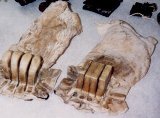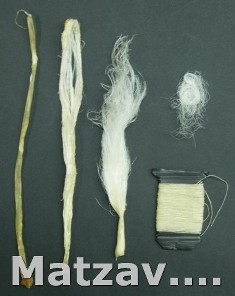 In recent years massive amounts of non-kosher and bedieved-kosher giddin, the special thread used to sew tefillin, Sifrei Torah, Nach and megillos have appeared in the STa”M marketplace. These giddin are sold to unsuspecting sofrim and then passed on to the kosher consumer. The problematic giddin is of 2 types. Giddin made from gid, sinews, taken from pigs, horses, camels and other tamei animals or made by non-Jews is pasul and pasuls the STa”M items in which it is used. Giddin processed by machine and thus not made lishmah lowers the kashrus level of divrei STa”M to being only kosher bidieved.
In recent years massive amounts of non-kosher and bedieved-kosher giddin, the special thread used to sew tefillin, Sifrei Torah, Nach and megillos have appeared in the STa”M marketplace. These giddin are sold to unsuspecting sofrim and then passed on to the kosher consumer. The problematic giddin is of 2 types. Giddin made from gid, sinews, taken from pigs, horses, camels and other tamei animals or made by non-Jews is pasul and pasuls the STa”M items in which it is used. Giddin processed by machine and thus not made lishmah lowers the kashrus level of divrei STa”M to being only kosher bidieved.
Information about this scandal has been very slow in becoming public knowledge. This is despite the fact that the Jerusalem Badatz, the Va’ad HaRabonim L’inyanei STa”M, Rav Mordechai Friedlander, Rav of Mishmeres STa”M of Jerusalem and Rav Shamai Kehos HaCohen Gross, Rav of Mishmeret Hakodesh have all issued strong warnings in the past to the public about it. Tefillin having only a general kashrus certificate are suspect as to the giddin used in them. They should be checked by a certified STa”M examiner and re-sewn with giddin having a hechsher.
How has this scam come about? Because few people are familiar with the complex laws of giddin, retzuot and tefillin batim. Most sellers of STa”M are not sofrim. Also, most sofrim only learn how to write STa”M without studying these additional halachot. Even many rabbis are unfamiliar with these halachot unless they have undertaken special study.
Due to the growth in size of the world-wide Jewish community and the attendant growth in the amount of divrei STa”M being produced, the making of giddin has become an industry on the order of magnitude of hundreds of thousands of dollars annually. Giddin without a hechsher is sold at a very low price at great profit to the illicit manufacturers. Those involved either are ignorant of the halachic requirements for kosher giddin or are knowingly ignoring these requirements for financial gain.
The amount of giddin used in a single pair of tefillin or even in a complete Torah scroll is very small. Thus, demanding kosher, mehudar giddin adds only minimally to the price. Just as with what we eat, tefillin, sifrei Torah, Nach and megillot need to have kashrus certification that includes supervision of the giddin used. The buyer must know who gives the kashrus certification and what is covered by the certificate. If it is not clear what the certification covers a Rabbi should be consulted before making the purchase.
For more details about this scandal and the ways in which it is being perpetrated see the article “A Kosher (Giddim) Stitch in Time” (here). For further halachic references and a list of the hiddurim present in mehudar giddin, see the following letter from Rav Shamai K’hat HaCohen Gross (here), Rav of Mishmeret Hakodesh for Sta”M, and the following letter from the Yerushalayim Badatz (here).
Additional Background Information: How Giddin is Made
 Giddin is thread made from the gid, sinew, of a kosher animal. The Shulchan Aruch, basing itself on halacha l’Moshe miSinai, specifies that giddin is the only thread that is kosher for sewing tefillin, Torah scrolls and megillot. The halachot of giddin detail which animals can be used as source material and how the giddin is to be made. Production of kosher giddin is both physically demanding and time consuming. It is almost an art form. Until very recently the skills involved, which can take years to learn, were usually passed down from generation to generation within individual families.
Giddin is thread made from the gid, sinew, of a kosher animal. The Shulchan Aruch, basing itself on halacha l’Moshe miSinai, specifies that giddin is the only thread that is kosher for sewing tefillin, Torah scrolls and megillot. The halachot of giddin detail which animals can be used as source material and how the giddin is to be made. Production of kosher giddin is both physically demanding and time consuming. It is almost an art form. Until very recently the skills involved, which can take years to learn, were usually passed down from generation to generation within individual families.
Only gid that comes from a kosher animal can be used to make giddin. Gid taken from a non-kosher animal such as pigs, horses, and camels is invalid for being made into giddin. The kosher animal does not need to be slaughtered according to Jewish Law in order to use its gid. Removal of the gid from the animal is normally, but not necessarily, done by a shochet.
The entire process of making the gid into giddin must be done by Jewish labor and every step must be done by hand. Before beginning his work the giddin-maker focuses his concentration and states aloud his intent to perform the mitzvah of making giddin, this is known as lishmah.
The raw gid sinews are dried, pounded and cleaned. They are combed using metal combs until very fine fibers are obtained. These fibers are then spun into thin threads. Single threads are doubled and spun a second time to create finished two-ply thread. The thread is then tested for strength and durability. Thin giddin is used for sewing tefillin while thicker giddin is used for sewing together the parchment sections of Sifrei Torah and megillos.
{Provided to Matzav.com thanks to HaSofer Moshe Flumenbaum. For more info contact http://www.HaSOFER.com or [email protected].}
{Matzav.com Newscenter}











